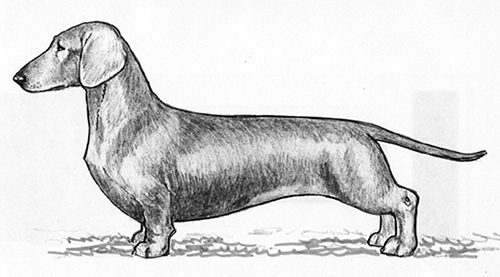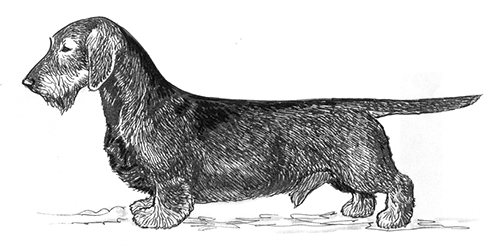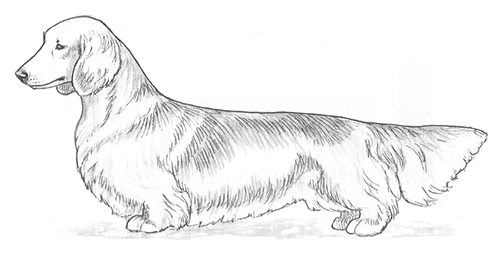Dachshund
Scenthound Group
The goals and purposes of this breed standard include: to furnish guidelines for breeders who wish to maintain the quality of their breed and to improve it; to advance this breed to a state of similarity throughout the world; and to act as a guide for judges.
Breeders and judges have the responsibility to avoid any conditions or exaggerations that are detrimental to the health, welfare, essence and soundness of this breed, and must take the responsibility to see that these are not perpetuated.
Any departure from the following should be considered a fault, and the seriousness with which the fault should be regarded should be in exact proportion to its degree and its effect upon the health and welfare of the dog and on the dogs ability to perform its traditional work.
History
Germany is recognized as the country of origin of the Dachshund. The breeds rootstock is thought to be a dwarf mutation of the taller hounds of the true German type. As early as the 17th century, the name "Dachshund" was applied to a breed type that encompassed smooth- and long-haired varieties. A third variety, the wirehair, was recognized in 1890. The name Dachshund is from "dachs", which means "badger", and "hund", which means "dog". Not only was the dog used to hunt badgers (as well as other small game), its appearance was much like the badger's, being sturdy and short-legged. In medieval books on hunting dogs, "Dachshund" was applied to those dogs that were similar in their tracking and trailing ability, and which possessed the proportions and temperaments of Terriers.
The United Kennel Club has recognized the Dachshund since 1919.
General Appearance
Low to the ground, short legged and long bodied, but with compact figure and robust muscular development, with a bold and confident carriage of head and an intelligent facial expression. Their conformation is preeminently fitted for following game into burrows.
In spite of his shortness of leg, in comparison with his length of trunk, he should not appear crippled, awkward, cramped in his capacity for movement, nor slim and weasel-like.
In addition, his hunting spirit, good nose, loud tongue and small size render him especially suited for beating the bush. His figure and fine nose give him the advantage over most other breeds of sporting dogs for trailing.
Characteristics
Hardy, vigorous, tireless, alert and responsive. Often described as "half-a-dog high and a dog-and-a-half long". Excellent hunting dog for small ground game.
He should be clever, lively, and courageous to the point of rashness, persevering in his work, both above and below the ground. All senses are well developed.
Head
Viewed from above or from the side, it should taper uniformly to the tip of the nose, and should be clean cut.
SKULL
The skull is only slightly arched, and should slope gradually without stop (the less stop the more typical) into the finely-formed, slightly-arched muzzle (so-called ram's nose). The bridge bones over the eyes should be strongly prominent.
MUZZLE
The nasal cartilage and tip of the nose are long and narrow.
The lips are tightly stretched, well covering the lower jaw, but neither deep nor pointed. The comers of the mouth are not very marked. The jaws open wide and are hinged well back of the eyes, with strongly developed bones and teeth.
NOSE
The nostrils are well open.
TEETH
A full complement of strong, white teeth meet in a scissors bite with the outer side of the lower incisors tightly touching the inner side of the upper incisors. The canine teeth are powerful.
EYES
Medium size, oval in shape, situated at the sides, with a clean, energetic, though pleasant expression, not piercing. Lustrous and very dark in color, dark reddish-brown to brownish-black for all coats and colors.
EARS
Set near the top of the head and not too far forward. Long, but not too long, beautifully rounded, not narrow, pointed or folded. Their carriage should be animated. The forward edge should just touch the cheek.
Neck
Fairly long, muscular and clean cut, not showing any dewlap on the throat. Slightly arched in the nape, extending in a graceful line into the shoulders, carried proudly, but not too stiffly.
Forequarters
The front must be muscular, compact, deep, long and broad to endure the arduous exertion underground. The shoulder blade is broad, and obliquely and firmly placed upon the fully developed thorax, furnished with hard and pliant muscles.
The upper arm is of the same length as the shoulder blade and at right angle to the latter. It is strong of bone and hard of muscle, lying close to the ribs and capable of free movement.
FORELEGS
The lower arm is short in comparison to other breeds and has a slight inward turn. It is supplied with hard but pliant muscles on the front and outside, with tightly stretched tendons on the inside and at the back.
The forearm and foot are joined by the pastern joint, and are closer together than the shoulder joints, so that the front leg does not appear absolutely straight.
The feet (paws) are full and broad in front, and a trifle inclined outwards. The feet are compact with well-arched toes and tough pads. There are five toes, but only four are in use. They should be close together, with a pronounced arch, provided on top with strong nails and underneath with tough toe pads. Dewclaws may be removed.
Body
The entire trunk should be long and fully muscled. The back (with sloping shoulders and short rigid, pelvis), should lie in the straightest possible line between the withers and the very slightly arched loin; the latter also being short, rigid and broad.
The topline should be in the straightest possible line between the withers and loin.
Chest
The breastbone should be strong and so prominent in front that on either side, a depression (dimple) appears. When viewed from the front, the thorax should appear oval and should extend downward to the midpoint of the forearm. The enclosing structure of ribs should appear full and oval and when viewed from above or from the side full-volumed so as to allow by its ample capacity complete development of the heart and lungs. Well ribbed up, and gradually merging into the line of the abdomen. If the length and anatomy of the shoulder and upper arm is correct, when viewed in profile the front leg should cover the lowest point of the breast line. The croup is long, round, full, robustly muscled, but pliant, sinking only slightly toward the tail. The abdomen is slightly drawn up.
Hindquarters
Viewed from behind, the hindquarters should be of equal width. The pelvic bones are not too short, rather strongly developed and moderately sloping. The thigh is robust and of good length; set at a right angle to the pelvic bones.
HIND LEGS
The hind legs are robust and well muscled, with well-rounded buttocks. The stifle joint is broad and strong. In comparison with other breeds, the tibia is short. It should be perpendicular to the femur and firmly muscled. The bones at the base of the foot should present a flat appearance, with a strongly prominent hock and a broad Achilles tendon. The central foot bones (metatarsus) should be long, moveable towards the tibia and slightly bent toward the front, but perpendicular (as viewed from behind). The hind feet (paws) have four compactly closed and beautifully arched toes, as in the front paws. The whole foot should be poised equally on the ball, not merely on the toes. The nails are short.
Tail
Set in continuation of the spine, extending without a very pronounced curvature. Should not be carried gaily.
Coat
There are three coat types:

SHORT-HAIRED (Smooth)
The hair is short, dense, smooth and shining. Special faults are: too fine or thin hair; leathery ears; bald patches; too coarse or too thin hair in general. The tail of the Short-Haired variety gradually tapers to a point and is well, but not too richly haired. Long, sleek bristles on the underside are considered a patch of strong growing hair, not a fault. A brush tail is a fault, as is a partly or wholly hairless tail.

WIRE-HAIRED
The general appearance is the same as that of the Short-Haired, but without being long in the legs, it is permissible for the body to be somewhat higher off the ground. With the exception of the jaw, eyebrows and ears, the whole body is covered with a perfectly uniform tight, short, thick, rough, hard coat, but with finer, shorter haired undercoat distributed within the coarser hairs. There should be a beard on the chin. The eyebrows are bushy. On the ears the hair is shorter than on the body, almost smooth, but conforming to the rest of the coat. The general arrangement of the hair should be such that the Wire-Haired Dachshund, when seen from a distance, should resemble a Smooth-Hair. Any sort of soft hair in the coat is faulty, whether long or short, or wherever found on the body. The same is true of long, curly or wavy hair, or hair that sticks out irregularly in all directions. The tail is robust, as thickly haired as possible, gradually coming to a point and without a tuft. A flag tail is objectionable.

LONG-HAIRED
The single differentiating characteristic of this variety from the other two is the rather long, silky hair. The soft, sleek, glistening, often slightly wavy hair should be long under the neck, on the underside of the body, and especially on the ears and behind the legs, becoming there a pronounced feather. The hair should fall beyond the lower edge of the ear. Short hair on the ear, so-called "leather" ears, is not desirable. Too luxurious a coat causes the Long-Hair to seem coarse, and masks the type. The coat should remind one of the Irish Setter, and should give the dog an excellent appearance. Too thick hair on the paws, so called "mops," is inelegant and renders the animal unfit for use. It is faulty for the dog to have equally long hair over all the body, if the coat is too curly, or too scrubby, or if a flag tail or overhanging hair on the ears is lacking, or if there is a very pronounced parting in the back, or a vigorous growth between the toes. The tail is carried gracefully in prolongation of the spine. The hair here attains its greatest length and forms a veritable flag.
All three varieties conform to the characteristics of the breed. The Long-Haired and Short-Haired are old, well-fixed varieties. The infusion of other breeds was purposely introduced into the Wire-Hair. Stress must be placed on conformity to the general Dachshund type.
Color
ONE-COLORED
This group includes red (often called tan), red-yellow and yellow, with or without a shading of interspersed black hairs. A clean color is preferable. Red is to be considered more desirable than red-yellow or yellow. Dogs strongly shaded with interspersed black hairs belong to this color group. White is not desirable, but a solitary small white spot is not a disqualification. Nose and nails are black; red is admissible, but not desirable.
TWO-COLORED
These have a base color of deep black, chocolate, gray or white, with rust-brown or yellow marks over the eyes, on the sides of the jaw and the lips, on the inner edge of the ear, front, breast, inside and behind the leg, on the paws and around the anus, and from there to about one-third to one-half of the length of the tail on the underside. (The most common two-colored Dachshund is usually called "Black & Tan.) Except on White dogs, white is not desirable, but a solitary small spot is not a disqualification. Undue prominence of tan markings is undesirable. Nose and nail colors are to be: black in black dogs; brown or black for Chocolate dogs; and gray or flesh for Gray dogs, but flesh is not desirable; and black for White dogs.
DAPPLED (Tiger) and STRIPED (Brindle)
The Dappled Dachshund is a clear brownish or grayish color, or even a white ground with dark irregular patches of dark gray, brown, red-yellow or black (large areas of one color are not desirable). Neither the light nor dark color should predominate.
The Striped Dachshund is red or yellow with a darker streaking. The nose and nail colors are the same as for the one- and two-colored Dachshunds.
Varieties
The Dachshund is divided into two varieties for conformation exhibition: Standard and Miniature.
STANDARD
Size & weight; over 11 (eleven) pounds, and up to and including 25 (twenty-five) pounds.
MINIATURE
Size & weight; Up to, and including, eleven pounds. The ideal weight being ten pounds. Symmetrical adherence to the general Dachshund conformation ideal, combined with smallness, and mental and physical vitality, should be the outstanding characteristics of Miniature Dachshunds.
Standards and Miniatures are bred in all three coats.
Special Note
Inasmuch as the Dachshund is a hunting dog, scars from honorable wounds shall not be considered a fault, nor shall they be penalized by Judges.
Major Faults
A weak, long-legged, or dragging figure. Body hanging between the shoulders. Sluggish, clumsy or waddling gait. Toes turned inward or too obliquely outward. Splayed paws. Sunken back, roached back. Croup higher than the withers. Short-ribbed or too weak chest. Excessively drawn up flanks. Narrow, poorly muscled hindquarters. Weak loins. Bad angulations in front or rear. Cowhocks. Bowed legs. Glass eyes (except in Gray or Dappled dogs). A bad coat.
Minor Faults
Ears wrongly set, sticking out, narrow or folded. Too marked a stop. Too pointed or too weak a jaw. Pincer teeth, distemper teeth. Too wide or short a head. Goggle eyes. Glass eyes in Gray or Dappled dogs. Insufficiently dark eyes in all coat colors. Short neck. Swan neck. Too fine or too thin hair.
Disqualifications
(A dog with a Disqualification must not be considered for placement in a conformation event, and must be reported to UKC.)
Unilateral or bilateral cryptorchid.
Viciousness or extreme shyness.
Overshot or undershot jaw.
Knuckling over.
Very loose shoulders.
Albinism.
Please Note
In UKC Conformation Shows, this breed is shown by variety in this order - Miniature, Standard.
Looking for a Dog?
Find a dog that will fit your family.
Note: The breeders on this list are not endorsed by UKC.
Revised January 1, 2008
©Copyright 1991, United Kennel Club
